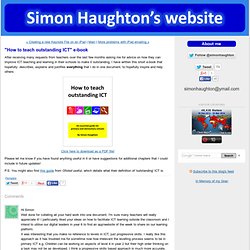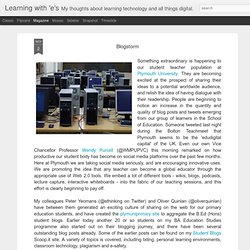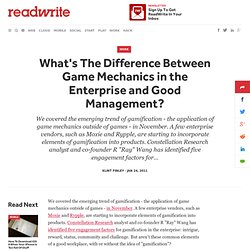

Solo Taxonomy. Google Apps Aligned with Bloom's Taxonomy. Unplug1. Bloomsapps. Using Blooms Taxonomy in education is a highly effective way to scaffold learning for the students.

With the recent popularity and pervasive nature of iOS devices in school districts it is essential for educators to understand how to implement Blooms in the classroom using the apps that are available. While this list is by no means fully comprehensive, it will assist educators in getting started when implementing iOS devices in the classroom.
This site will change almost daily as it will be updated with new and exciting apps! If you find any that you have worked with in your classroom please email dmileham@e1b.org or tweet @bloomsapps or @dmileham75 with your suggestions. Thanks for checking the site! Two Links to some iTunesU courses relating to iOS Integration: 1 iPad by Erie 1 Boards of Cooperative Educational Services ( Movie Making\Digital Storytelling Camera to PDF Free - cool little app that turns your device into a scanner. LiveBinders: I would be remiss if I didn't post this.
Why My Six-Year-Olds Blog (And Why Your Students Should, Too) Digital Portfolios | Viewpoint Why My Six-Year-Olds Blog (And Why Your Students Should, Too) In a digital world, learners of every age should be taking their first steps toward establishing an online presence.

Here's why. By Kathy Cassidy08/27/13 The first blog entries posted by my grade one students are rarely readable. SOCIAL LEARNING PLATFORM. Bloom's and ICT tools. Many teachers use Bloom's Taxonomy and Bloom's Revised Taxonomy in developing and structuring their teaching & learning experiences.

Bloom's Digital taxonomy is an attempt to marry Bloom's revised taxonomy and the key verbs to digital approaches and tools. This is not a replacements to the verbs in the revised taxonomy, rather it suppliments and supports these by including recent developments, processes and tools. Common Craft. ICT in schools 2008-11. BalancEdTech - home. ICT Progression Documents and resources to download. NAACE Primary: Curriculum Support. World Wide Web. Have you ever wondered, when you visit a website, where those words and images come from?

These days, as long as we have an Internet connection, using the Web is pretty easy. We can visit billions of pages on things from pet alligators to the weather in Holland. To help figure out how it works, let’s pretend we can get really small, follow the wires and explore what makes the Web work. In order to get to the Web, we need a connection from our home or business to the rest of the online world. This usually happens through the phone or cable lines, or even satellite. If we could see the connection, the information coming through it would look like little packets of code.
For this, we use a web browser. It’s called a “server.” We do this with web addresses. The reason we call it a “web” is that all the servers are connected. Web pages use shortcuts or “links” – words and images we can click, that direct us to page after page. Together, this system makes up the World Wide Web. "How to teach outstanding ICT" e-book. After receiving many requests from teachers over the last few months asking me for advice on how they can improve ICT teaching and learning in their schools to make it outstanding, I have written this short e-book that hopefully: describes, explains and justifies everything that I do in one document, to hopefully inspire and help others: Click here to download as a PDF file!

Please let me know if you have found anything useful in it or have suggestions for additional chapters that I could include in future updates! P.S. You might also find this guide from Ofsted useful, which details what their definition of 'outstanding' ICT is. Edjudo — Supporting Technology in High School. What Is RSS? RSS Explained - www.WhatIsRSS.com. Simon Haughton's Blog: Discussion of ICT Issues.
National curriculum in England: computing programmes of study - Publications. Skip to main content GOV.UK uses cookies which are essential for the site to work.

We also use non-essential cookies to help us improve government digital services. Any data collected is anonymised. The Whiteboard Blog - Supporting the use of technology in the classroom. Part 1… Creativity In The Digital Classroom… Over 40 Resources… Are They in Your School? I hope you enjoyed the past post and welcome you to a series of posts dedicated to Creativity in digital classroom.

I have some reflections, ideas, and some amazing resources to share. Please enjoy and share this post via email or a retweet. While you are at it, I would appreciate that you take a moment to subscribe to this Blog by RSS or email and follow me at (mjgormans). Also, feel free to contact me about any conference, in-service plans, or PD you might wish to include me in. (mjgormans@gmail.com). I believe that creativity is necessary in today’s classroom. Free software that is stored locally on your classroom computers or network - Current PostWeb 2.0 applications accessible using the internet… with just about any device - be sure to subscribe! Why My Six-Year-Olds Blog (And Why Your Students Should, Too) Kathy Schrock's Guide to Everything - Home Page. Blogstorm. Something extraordinary is happening to our student teacher population at Plymouth University.

They are becoming excited at the prospect of sharing their ideas to a potential worldwide audience, and relish the idea of having dialogue with their readership. People are beginning to notice an increase in the quantity and quality of blog posts and tweets emerging from our group of learners in the School of Education. Someone tweeted last night during the Bolton Teachmeet that Plymouth seems to be the 'edudigital capital' of the UK. Even our own Vice Chancellor Professor Wendy Purcell (@WMPUPVC) this morning remarked on how productive our student body has become on social media platforms over the past few months.
Here at Plymouth we are taking social media seriously, and are encouraging innovative uses. What do the students learn from blogging? Literacy in the Digital Age. Simon Haughton's Blog. What's The Difference Between Game Mechanics in the Enterprise and Good Management? We covered the emerging trend of gamification - the application of game mechanics outside of games - in November.

A few enterprise vendors, such as Moxie and Rypple, are starting to incorporate elements of gamification into products. Constellation Research analyst and co-founder R "Ray" Wang has identified five engagement factors for gamification in the enterprise: intrigue, reward, status, community and challenge. But aren't these common elements of a good workplace, with or without the idea of "gamification"? First of all - why apply gamification principles in the enterprise? Wang notes the following applications: TrainingCollaboration and knowledge sharingCustomer loyalty programsAd network optimizationVirtual goods and currencies. I can see the applications for customer-facing programs, but how well will internal programs work out? Intrigue is obviously the hard part. When we covered gamification before we quoted Margaret Robertson: Photo by andi.vs.zf. CT-Article1. From Dawn till Dusk – Games and life » About.